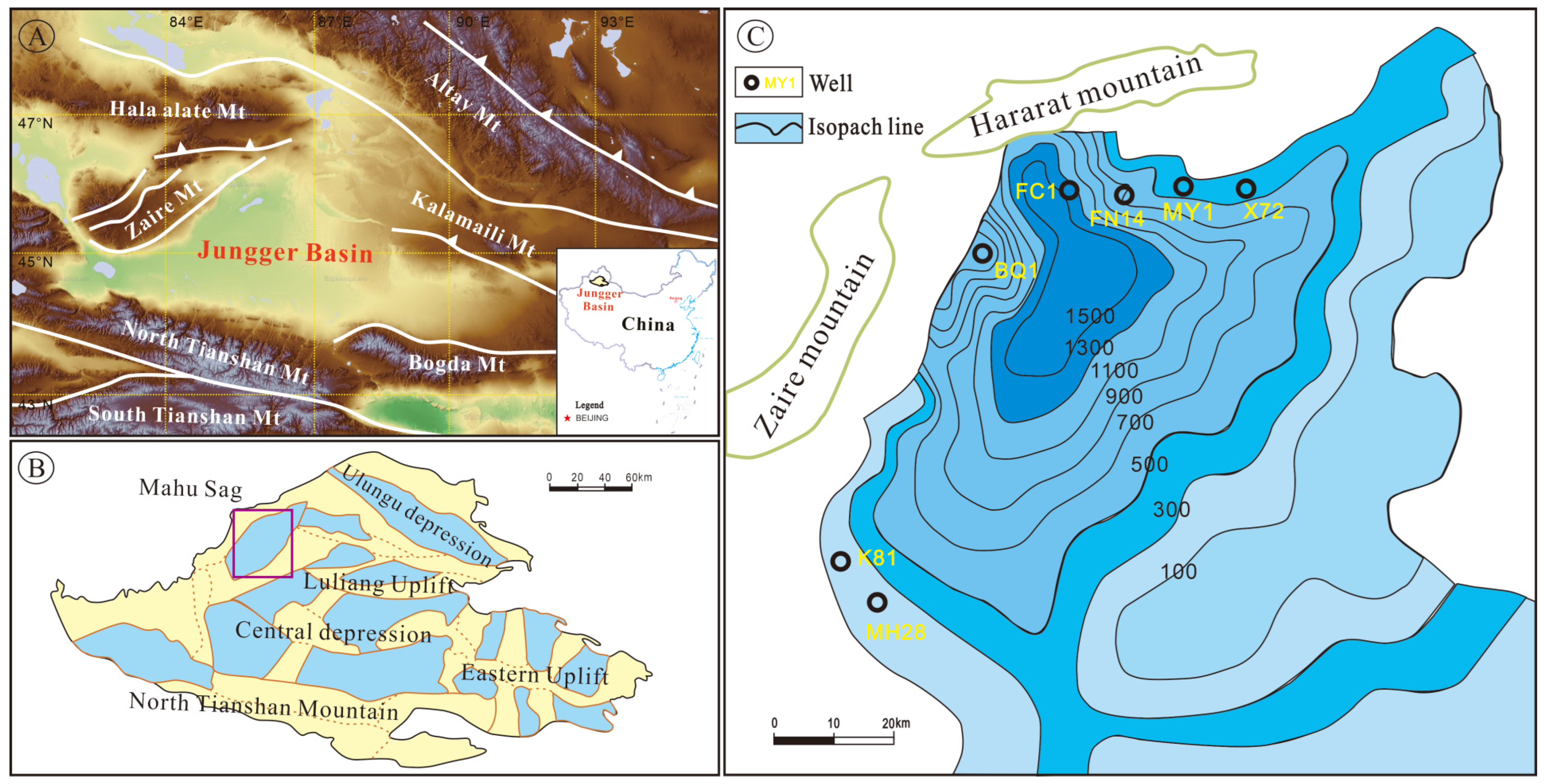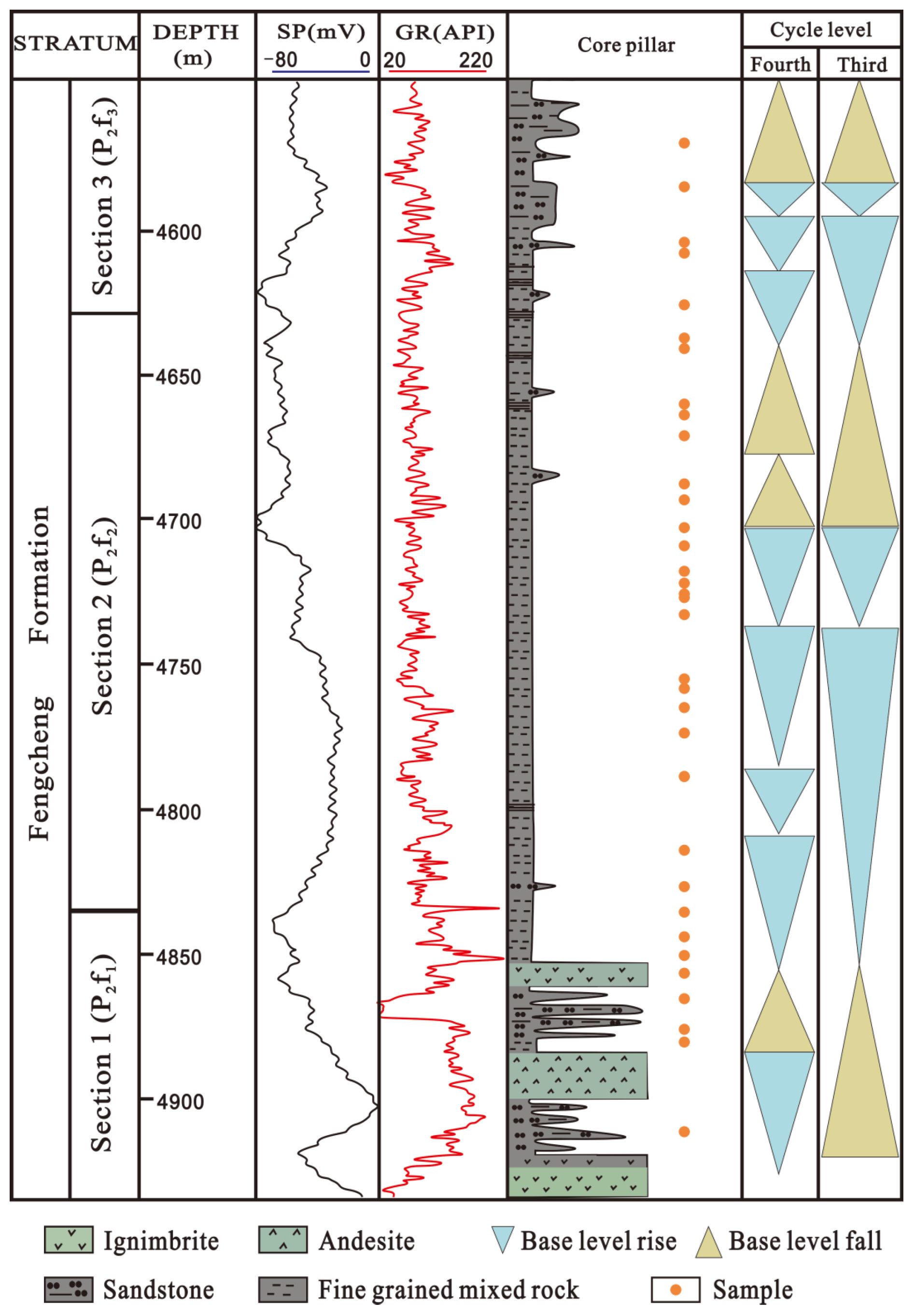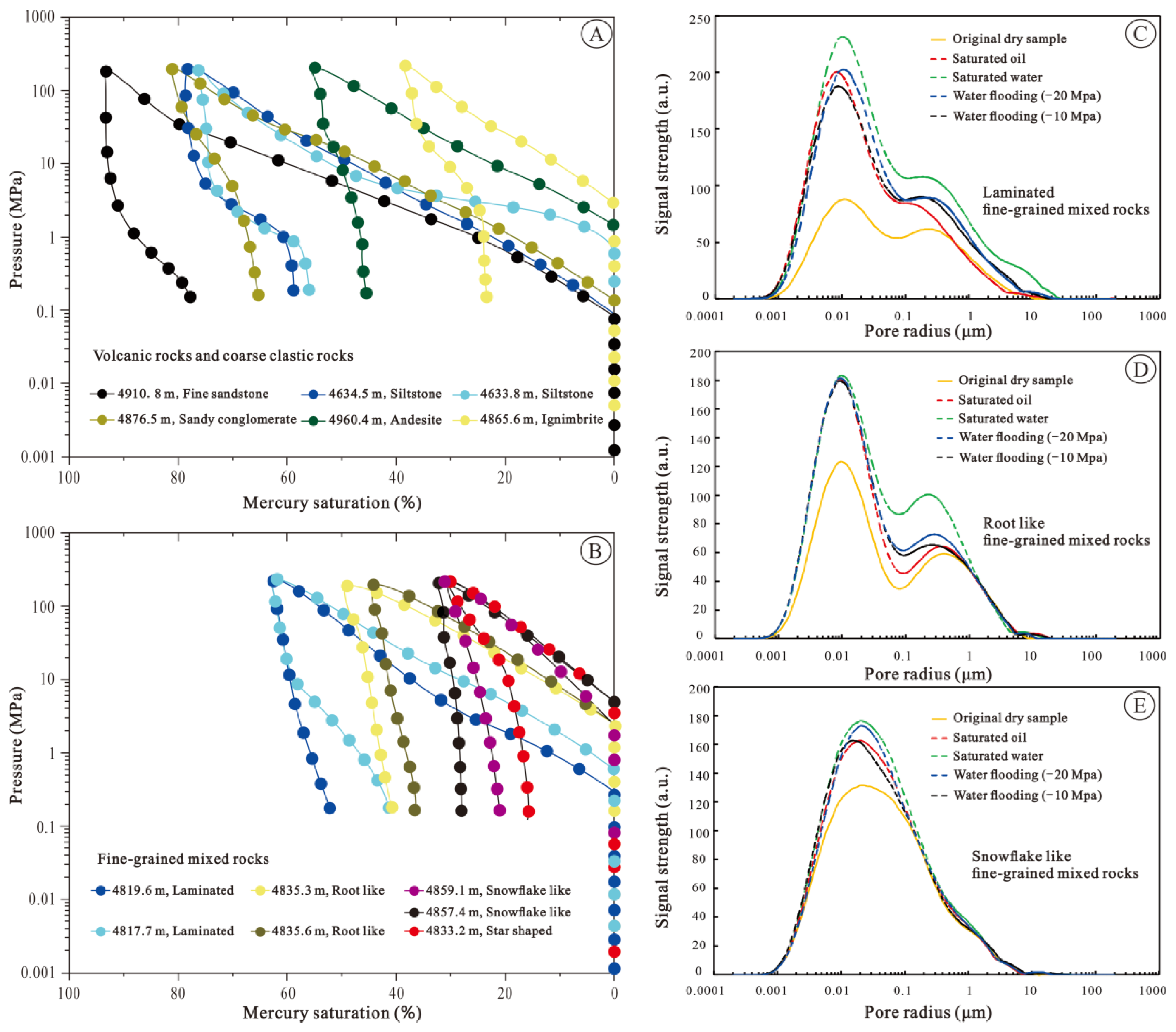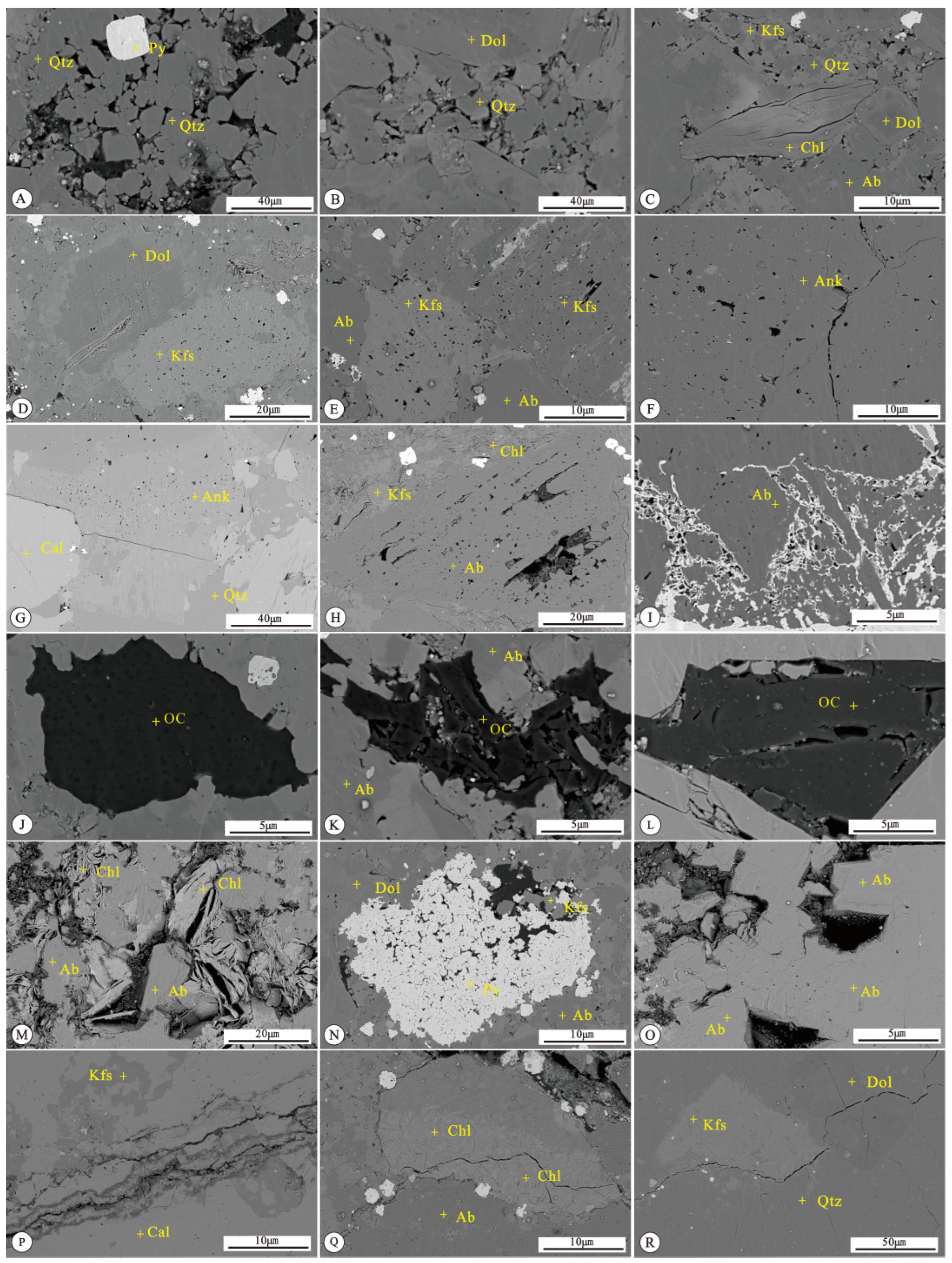Classification and Analysis of Dominant Lithofacies of the Fengcheng Formation Shale Oil Reservoirs in the Mahu Sag, Junggar Basin, NW China
Abstract
1. Introduction
2. Geological Background and Material
2.1. Geological Background
2.2. Methods and Materials
2.2.1. Centimeter-Level Core Observation
2.2.2. Microscopic Analysis
3. Results and Analyses
3.1. Layer Thickness and Structural Development Characteristics
3.2. Rock Composition
3.3. Porosity and Permeability
3.4. Storage Space Characteristics
- (1)
- The reservoir spaces in sandstone are predominantly represented by intergranular and secondary dissolution pores (Figure 7A–C). When primary intergranular pores are concentrated and developed, the overall clay mineral content is low, and debris particles mostly exhibit point-to-line contact. The remaining primary intergranular pores are either unfilled or filled, with a small amount of authigenic clay minerals. The close proximity of debris sources and the influence of volcanic activity in the source area contribute to a high feldspar mineral content. During later diagenetic evolution, organic acid dissolution generates abundant dissolution pores, forming a crucial foundation for high-quality reservoir formation.
- (2)
- Endogenous rock reservoirs: Endogenous rocks within the Fengcheng Formation, mainly evaporites, contain storage spaces consisting of intergranular pores within mudstone, dolomite, and limestone. The pores in dolomite crystals vary in size from micrometers to nanometers. Sodium carbonate, calcium limestone, and soda stone, formed in the sedimentary background of saline–alkali lakes, often exhibit lens-like and sporadic developmental characteristics. Due to their interlayered nature within fine-grained mixed rocks, obtaining thin-section samples is challenging. Hand specimens display coarse crystals with columnar aggregates and relatively large intergranular pores ranging from micrometers to millimeters.
- (3)
- Fine-grained mixed rock reservoirs: Characterized by the symbiotic relationship between terrestrial debris and endogenous minerals, exhibit storage space with combined characteristics of clastic and endogenous rocks. In contrast to sandstone and conglomerate reservoirs, the intergranular pore size in fine-grained mixed rocks is notably small, primarily manifesting as residual primary intergranular and intergranular dissolution pores. Primary intergranular pores are semi-filled with clay minerals, showcasing an average pore size distribution range of 10–100 μm, characterized by micrometer-sized pores with relatively high connectivity. Secondary dissolution pores (Figure 7D–I) result from the dissolution of endogenous authigenic dolomite and terrigenous detrital feldspar particles. These pores are distributed in an isolated manner, exhibiting poor connectivity. Dissolution pores of feldspar mainly exist in potassium feldspar particles, forming micro–nanoscale contiguous pores, and are also present in several sodium feldspar crystals. Organic matter pores (Figure 7J–L) are spindle- and bubble-shaped, planar isolated, and polygonal, with pore sizes mainly below 2 μm. Intergranular pores consist mainly of calcite and authigenic clay mineral intergranular pores (Figure 7M–O), displaying a dense development and spindle-like shape, with high connectivity in the pore plane. The distribution range is 2–5 μm. Microcracks manifest as edge and intragranular cracks in debris particles (Figure 7P–R). The crack extension exceeds 10 μm, and the seam width is less than 1 μm. The lower secondary mineral filling and a higher degree of opening in the cracks contribute to an increase in reservoir permeability.
4. Discussion
4.1. Classification of Reservoir Types
4.2. Characteristics of Mixed Rock Reservoirs
4.3. Mechanism of Hydrocarbon Occurrence
5. Conclusions
- (1)
- Shale oil reservoirs within the Fengcheng Formation in the Mahu Sag exhibit distinct types, including gravel, endogenous, fine-grained mixed rock, and volcanic rock. Among these, gravel reservoirs demonstrate the highest storage capacity, whereas endogenous rock exhibits the lowest. Fine-grained mixed rock and volcanic rock fall within the moderate range. Notably, fine-grained mixed-rock reservoirs emerge as favorable targets for subsequent exploration owing to their advantageous porosity, permeability, and structural characteristics. The reservoir space types within the Fengcheng Formation shale oil reservoir vary owing to differences in rock types. Volcanic reservoirs primarily consist of pores and microcracks, representing major storage spaces. Gravel reservoirs, on the other hand, exhibit widely developed secondary dissolution pores. Beyond the typical primary, intergranular, and secondary dissolution pores in conventional reservoirs, the presence of organic matter pores in fine-grained mixed-rock shale oil reservoirs becomes crucial, creating conditions conducive to the formation of high-quality reservoirs.
- (2)
- Fine-grained mixed-rock reservoirs can be categorized into two types: mixed shale and mixed mudstone. The porosity and permeability of mixed shale reservoirs surpass those of mixed mudstone reservoirs. Further subdivision of mixed mudstone includes layered or similarly layered, tree root or network, and snowflake- or star-shaped mixed mudstone, based on mineral development and performance characteristics. As observed, the physical properties of the reservoirs degrade gradually, leading to a continuous decline in storage capacity. The free oil content in the Fengcheng Formation shale oil reservoir is primarily controlled by mineralogical composition. As the quartz and carbonate mineral content increases, the free oil content initially rises but subsequently declines, whereas an increase in argillaceous mineral content corresponds to a reduction in the proportion of free oil.
- (3)
- The lithology of the Fengcheng Formation reservoir changes rapidly at the centimeter to decimeter scale. This strong heterogeneity increases the difficulty of identifying sweet spots and shale oil production. Multi-modal logging techniques (e.g., NMR + acoustic imaging) can enable precise formation identification, and the control accuracy of horizontal well trajectories needs to reach the sub-meter level.
Author Contributions
Funding
Data Availability Statement
Acknowledgments
Conflicts of Interest
References
- Zou, C.; Yang, Z.; Li, G.; Li, J.; Liu, X.; Tang, Y.; Jiang, T.; Yang, Y.; Bai, X.; Pan, S.; et al. Why Can China Realize the Continental “Shale Oil Revolution”? J. Earth Sci. 2022, 33, 1324–1327. [Google Scholar] [CrossRef]
- Li, M.; Jin, Z.; Dong, M.; Ma, X.; Li, Z. Advances in the basic study of lacustrine shale evolution and shale oil accumulation. Pet. Geol. Exp. 2020, 42, 489–505. [Google Scholar] [CrossRef]
- Wang, Q.; Tao, S.; Guan, P. Progress in research and exploration & development of shale oil in continental basins in China. Nat. Gas Geosci. 2020, 31, 417–427. [Google Scholar] [CrossRef]
- Wang, G. Strategic Significance and Research Direction for Gulong Shale Oil. Pet. Geol. Oilfield Dev. Daqing 2020, 39, 8–19. [Google Scholar] [CrossRef]
- Fu, J.; Li, S.; Hou, Y.; Zhou, X.; Liu, J.; Li, S. Breakthrough of risk exploration for Class II shale oil in Chang 7 member of the Yanchang Formation and its significance in the Ordos Basin. China Pet. Explor. 2020, 25, 78–92. [Google Scholar] [CrossRef]
- Ma, W.; Wang, Y.; Zhang, S.; Feng, S.; Hao, B.; Cui, X. Microscopic characteristics and controlling factors of Chang 7 Member shale oil reservoir in northern Shaanxi area, Ordos Basin. Nat. Gas Geosci. 2021, 32, 1810–1821. [Google Scholar] [CrossRef]
- Zhang, B.; Mao, Z.; Zhang, Z.; Yuan, Y.; Chen, X.; Shi, Y.; Liu, G.; Shao, X. Black Shale Formation Environment and Its Control on Shale Oil Enrichment in Triassic Chang 7 Member, Ordos Basin, NW China. Pet. Explor. Dev. 2021, 48, 1304–1314. [Google Scholar] [CrossRef]
- Fu, J.; Guo, W.; Li, S.; Liu, X.; Cheng, D.; Zhou, X. Characteristics and exploration potential of muti-type shale oil in the 7th Member of Yanchang Formation, Ordos Basin. Nat. Gas Geosci. 2021, 32, 1749–1761. [Google Scholar] [CrossRef]
- He, W.; Meng, Q.; Feng, Z.; Zhang, J.; Wang, R. In-situ accumulation theory and exploration & development practice of Gulong shale oil in Songliao Basin. Acta Pet. Sin. 2022, 43, 1–14. [Google Scholar] [CrossRef]
- Liang, C.; Zhang, J.; Zhu, J.; Wang, W.; Guo, H.; Tan, Q.; Zhao, J.; Luo, H. The Influence of Continental Mixosedimentite Sedimentation on Shale Oil Sweet Spot: A Case Study on the Permian Lucaogou Formation in the Jimsar Sag of the Junggar Basin, NW China. Front. Earth Sci. 2022, 10, 929768. [Google Scholar] [CrossRef]
- Zhang, K.; Yuan, X.; Han, F. Editorial: Reservoir Formation Conditions and Enrichment Mechanisms of Shale Oil and Gas. Front. Earth Sci. 2023, 10, 1047581. [Google Scholar] [CrossRef]
- Liu, X.; Li, D.; Jia, Y.; Liyong, Y.; Xiaoting, G.; Tao, Z.; Ziwei, C.; Mao, L.; Juan, W.; Xiangyun, S.; et al. Optimizing Construction Parameters for Fractured Horizontal Wells in Shale Oil. Front. Earth Sci. 2023, 10, 1015107. [Google Scholar] [CrossRef]
- Li, Y.; Zhao, Q.; Lyu, Q.; Xue, Z.; Cao, X.; Liu, Z. Evaluation Technology and Practice of Continental Shale Oil Development in China. Pet. Explor. Dev. 2022, 49, 1098–1109. [Google Scholar] [CrossRef]
- Zhi, D.; Guo, X.; Wang, W.; Jin, Y.; Liu, C.; Chen, G.; Wang, Z. Fracturing and Production Analysis of the Efficacy of Hydraulic Fracture Stage Reduction in the Improvement of Cost-Effectiveness in Shale Oil Development: A Case Study of Jimsar Shale Oil, China. Energy Sci. Eng. 2021, 9, 1337–1348. [Google Scholar] [CrossRef]
- Wang, X. Identification and Significance of Milankovitch Astronomical Cycles of Fine-Grained Sedimentary Rocks, Permian Fengcheng Formation in Mahu Sag. J. Northwest Univ. (Nat. Sci. Ed.) 2022, 52, 128–143. [Google Scholar] [CrossRef]
- Bian, C.; Guo, B.; Pu, X.; Zeng, X.; Liu, W.; Li, Y.; Zhou, K.; Tian, Q.; Ma, C. Lithofacies Characteristics and Their Effects on Shale Oil Enrichment: A Case Study from Shahejie Formation of the Qibei Sag, Bohai Bay Basin, China. Energies 2023, 16, 2107. [Google Scholar] [CrossRef]
- Xu, S.; Gou, Q. The Importance of Laminae for China Lacustrine Shale Oil Enrichment: A Review. Energies 2023, 16, 1661. [Google Scholar] [CrossRef]
- Pang, X.; Wang, G.; Kuang, L.; Zhao, F.; Li, C.; Wang, C.; Zhang, M.; Lai, J. Lamellation Fractures in Shale Oil Reservoirs: Recognition, Prediction and Their Influence on Oil Enrichment. Mar. Pet. Geol. 2023, 148, 106032. [Google Scholar] [CrossRef]
- Qiao, J.; Luo, Q.; Zhang, Y.; Wang, D.; Cui, H.; Shang, X.; Liu, L.; Zhang, T. Formation Conditions and Enrichment Mechanisms of the Jurassic Lacustrine Organic-Rich Shale in the East Fukang Sag, Junggar Basin, NW China: A Reassessment Based on Organic Geochemistry. Front. Earth Sci. 2023, 11, 1086827. [Google Scholar] [CrossRef]
- Li, W.; Cao, J.; Zhi, D.; Tang, Y.; He, W.; Wang, T.; Xia, L. Controls on Shale Oil Accumulation in Alkaline Lacustrine Settings: Late Paleozoic Fengcheng Formation, Northwestern Junggar Basin. Mar. Pet. Geol. 2021, 129, 105107. [Google Scholar] [CrossRef]
- He, W.; Qian, Y.; Zhao, Y.; Li, N.; Zhao, X.; Liu, G.; Miao, G. Exploration Implications of Total Petroleum System in Fengcheng Formation, Mahu Sag, Junggar Basin. Xinjiang Pet. Geol. 2021, 42, 641. [Google Scholar] [CrossRef]
- Tang, Y.; Cao, J.; He, W.-J.; Guo, X.-G.; Zhao, K.-B.; Li, W.-W. Discovery of Shale Oil in Alkaline Lacustrine Basins: The Late Paleozoic Fengcheng Formation, Mahu Sag, Junggar Basin, China. Pet. Sci. 2021, 18, 1281–1293. [Google Scholar] [CrossRef]
- Tang, Y.; Lv, Z.; He, W.; Qing, Y.; Song, X.; Cao, Q.; Qian, Y.; Zhu, T.; Li, N.; Li, X. Characteristics and Genesis of Alkaline Lacustrine Tight Oil Reservoirs in the Permian Fengcheng Formation in the Mahu Sag, Junggar Basin, NW China. Minerals 2022, 12, 979. [Google Scholar] [CrossRef]
- Du, X.; Jin, Z.; Zeng, L.; Liu, G.; He, W.; Ostadhassan, M.; Song, Y.; Liang, X.; Yang, S.; Lu, G. Formation of Natural Fractures and Their Impact on Shale Oil Accumulation in the Mahu Sag, Junggar Basin, NW China. Int. J. Coal Geol. 2023, 279, 104385. [Google Scholar] [CrossRef]
- Tang, Y.; He, W.; Wang, R.; Ren, H.; Jin, Z.; Yang, Z.; Zhang, Y. Cyclostratigraphy of Lower Permian Alkaline Lacustrine Deposits in the Mahu Sag, Junggar Basin and Its Stratigraphic Implication. Front. Earth Sci. 2023, 11, 1232418. [Google Scholar] [CrossRef]
- Zhang, Z.; Yuan, X.; Wang, M.; Zhou, C.; Tang, Y.; Chen, X.; Lin, M.; Cheng, D. Alkaline-Lacustrine Deposition and Paleoenvironmental Evolution in Permian Fengcheng Formation at the Mahu Sag, Junggar Basin, NW China. Pet. Explor. Dev. 2018, 45, 1036–1049. [Google Scholar] [CrossRef]
- Wang, S.; Wang, G.; Zeng, L.; Liu, P.; Huang, Y.; Li, S.; Wang, Z.; Zhou, Y. New Method for Logging Identification of Natural Fractures in Shale Reservoirs: The Fengcheng Formation of the Mahu Sag, China. Mar. Pet. Geol. 2025, 176, 107346. [Google Scholar] [CrossRef]
- Zhang, Z.; Qin, J.; Ba, Z.; Huang, W.; Han, M.; Gao, Y.; Wu, D. Diagenetic Facies of the Fengcheng Formation Tight Reservoir in the Alkaline Lake Sedimentary Environment, the Southern Margin of Mahu Sag, Junggar Basin, China. J. Nat. Gas Geosci. 2025, 10, 41–57. [Google Scholar] [CrossRef]
- Haile, B.G.; Klausen, T.G.; Czarniecka, U.; Xi, K.; Jahren, J.; Hellevang, H. How Are Diagenesis and Reservoir Quality Linked to Depositional Facies? A Deltaic Succession, Edgeøya, Svalbard. Mar. Pet. Geol. 2018, 92, 519–546. [Google Scholar] [CrossRef]
- Xiao, D.; Cao, J.; Tan, X.; Xiong, Y.; Zhang, D.; Dong, G.; Lu, Z. Marine Carbonate Reservoirs Formed in Evaporite Sequences in Sedimentary Basins: A Review and New Model of Epeiric Basin-Scale Moldic Reservoirs. Earth-Sci. Rev. 2021, 223, 103860. [Google Scholar] [CrossRef]
- Song, Y.; Yang, Z.; He, W.; Gan, R.; Zhang, R.; Huang, L.; Xu, P.; Zhao, X.; Chen, Z. Exploration progress of alkaline lake type shale oil of the Permian Fengcheng Formation in Mahu Sag, Junggar Basin. China Pet. Explor. 2022, 27, 60–72. [Google Scholar] [CrossRef]
- Lei, H.; Guo, P.; Meng, Y.; Qi, J.; Liu, J.; Zhang, J.; Liu, M.; Zhang, Y. Pore structure and classification evaluation of shale oil reservoirs of Permian Fengcheng Formation in Mahu Sag. Lithol. Reserv. 2022, 34, 142–153. [Google Scholar] [CrossRef]
- Zhu, S.; Zhu, X.; Liu, Y.; Chen, X.; Wang, J.; Wang, X.; Ma, A. Petrological and Geochemical Features of Dolomitic Rocks in the Lower Permian Fengcheng Formation in Wuerhe—Xiazijie Area, Junggar Basin. Geol. Rev. 2014, 60, 1113–1122. [Google Scholar] [CrossRef]
- Lin, X.; Qiusheng, C.; Lingli, F.; Ni, Z.; Huan, L. The Reservoir Characteristics and Control Factors of Shale Oil in Permian Fengcheng Formation of Mahu Sag, Junggar Basin. China Pet. Explor. 2019, 24, 649–660. [Google Scholar] [CrossRef]
- Mount, J.F. Mixing of Siliciclastic and Carbonate Sediments in Shallow Shelf Environments. Geology 1984, 12, 432–435. [Google Scholar] [CrossRef]
- Sha, Q. Discussion on mixing deposit and hunji rock. J. Palaeogeogr. 2021, 3, 63–66. [Google Scholar]
- Zhang, J.; Jiang, Z.; Liu, P.; Kong, X.; Ge, Y. Deposition Mechanism and Geological Assessment of Continental Ultrafine-Grained Shale Oil Reservoirs. Acta Pet. Sin. 2022, 43, 234–249. [Google Scholar] [CrossRef]
- Yu, B. Particularity of shale gas reservoir and its evaluation. Earth Sci. Front. 2012, 19, 252–258. [Google Scholar]
- Wang, M. Evaluation Index System of Shale Oil Reservoirs. Geochimica 2017, 46, 178–190. [Google Scholar] [CrossRef]
- Kuang, L.; Hou, L.; Yang, Z.; Wu, S. Key parameters and methods of lacustrine shale oil reservoir characterization. Acta Pet. Sin. 2021, 42, 1–14. [Google Scholar] [CrossRef]
- Pszonka, J.; Sala, D. Application of the Mineral Liberation Analysis (MLA) for Extraction of Grain Size and Shape Measurements in Siliciclastic Sedimentary Rocks. In Proceedings of the AG 2018—4th International Conference on Applied Geophysics, Cracow, Poland, 28–29 June 2018; Volume 66, p. 02002. [Google Scholar]
- Pszonka, J.; Godlewski, P.; Fheed, A.; Dwornik, M.; Schulz, B.; Wendorff, M. Identification and Quantification of Intergranular Volume Using SEM Automated Mineralogy. Mar. Pet. Geol. 2024, 162, 106708. [Google Scholar] [CrossRef]
- Yue, L.; Meng, Q.Q.; Liu, Z.L.; Yang, W.; Jin, H.; Shen, F.; Zhang, J.J.; Liu, S.B. Physical property and heterogeneity of tight sandstone reservoirs: A case of the Upper Triassic 6th member of Xujiahe Formation, Guang’an, central Sichuan Basin. Oil Gas Geol. 2022, 43, 597–609. [Google Scholar]
- Ehrenberg, S.N.; Walderhaug, O.; Bjørlykke, K. Carbonate Porosity Creation by Mesogenetic Dissolution: Reality or Illusion?Geohorizons. AAPG Bull. 2012, 96, 217–233. [Google Scholar] [CrossRef]
- Jarvie, D. Part 2: Shale-Oil Resource Systems. In Shale Resource Systems for Oil and Gas; AAPG Memoir; American Association of Petroleum Geologists: Tulsa, OK, USA, 2012; Volume 97, pp. 89–119. ISBN 978-1-62981-011-9. [Google Scholar]
- Zhang, Y.; Barber, T.J.; Hu, Q.; Bleuel, M.; El-Sobky, H.F. Complementary Neutron Scattering, Mercury Intrusion and SEM Imaging Approaches to Micro- and Nano-Pore Structure Characterization of Tight Rocks: A Case Study of the Bakken Shale. Int. J. Coal Geol. 2019, 212, 103252. [Google Scholar] [CrossRef]
- Bade, S.O.; Gyimah, E.; Tomomewo, O.; Josephs, R.; Omojiba, T.; Aluah, R. Assessing the Potential of Large-Scale Geological Hydrogen Storage in North Dakota’s Bakken Formation: A Case Study Integrating Wind-Powered Hydrogen Production. Renew. Energy 2024, 237, 121906. [Google Scholar] [CrossRef]









| Rock Type | Clastic Rock | Volcanic Rock | Dolomite | Fine Grained Mixed Rock | ||||||||
|---|---|---|---|---|---|---|---|---|---|---|---|---|
| Lithology | Argillaceous Siltstone | Dolomitic Siltstone, Siltstone | Fine Muddy Sandstone, Fine Silty Sandstone, Fine Sandstone | Silty Sandstone with Muddy Gravel | Medium-Fine Calcium Sanstone | Medium Coarse Sandstone, Coarse Sandstone, Coarse Sandstone with Gravel, Sandy Conglomerate | Andesite and Fused Tuff | Limestone and Mudstone | Dolomitic Mudstone/Shale | Dolomitic-Silty Mudstone/Shale | Silty Mudstone/Shale | Mudstone Containing Dolomite/Shale |
| Colour | Light gray white, silver gray, gray, light green gray | Light green gray, light gray brown | light gray | Black, black gray, dark gray, light gray | ||||||||
| Thickenss | Laminae, thin layer, middle layer, thick layer, extremely thick layer | Thick layer, extremely thick layer | Thin layer, laminated layer | Layer, thin layer, middle layer | ||||||||
| Structure | Parallel bedding, granular bedding, and lenticular bedding | Blocky, angular, and coiled | lenticular | Page bedding, lens like bedding, horizontal bedding | ||||||||
| Characteristic mineral | Pyrite | Turbidite and quartz | / | Flint, calcareous minerals, datolite, gypsum | ||||||||
| Enrichment forms of characteristic minerals | Nodular | Pore filling | / | Layered-similar layer, rooted or networked, snowflake or star shaped | ||||||||
| Development of cracks | Near vertical cracks, near horizontal cracks, suture lines | Near vertical cracks, near horizontal cracks, suture lines | / | Page seams, near horizontal cracks, suture lines | ||||||||
| Oiliness | Rich in oil, oil immersion, oil spots, and oil stains | Rich in oil, oil immersion, oil spots, and oil stains | / | Oil immersion, oil stains, oil stains | ||||||||
| Pore | Cracks, mineral dissolution pores | Cracks and pores | / | Mineral dissolution pores, intergranular pores, cracks | ||||||||
| Reservoir Type | Rock Type | Layer Thickness Characteristics | Lithology | Developmental Position | |
|---|---|---|---|---|---|
| Major Categories | Subcategories | ||||
| Type Ⅰ | Sand conglomerate reservoir | Conglomerate | Super-thick layer (>1.0 m) | Fine conglomerate, fine Sandy conglomerate | P2f1 |
| Thick layer (0.3–1.0 m) | |||||
| Medium layer (0.1–0.3 m) | |||||
| Thin layer (<0.1 m) | |||||
| Sandstone | Super-thick layer (>1.0 m) | Coarse pebbled sandstone, medium-coarse sandstone, fine sandstone, medium-fine calcareous/dolomitic sandstone, fine argillaceous silty sandstone, fine silty sandstone | P2f3 P2f2 P2f1 | ||
| Thick layer (0.3–1.0 m) | |||||
| Medium layer (0.1–0.3 m) | |||||
| Thin layer (<0.1 m) | |||||
| Siltstone | Thick layer (0.3–1.0 m) | Calcareous argillaceous siltstone, dolomitic siltstone | P2f3 P2f2 P2f1 | ||
| Medium layer (0.1–0.3 m) | |||||
| Thin layer (<0.1 m) | |||||
| Type Ⅱ | Volcanic reservoir | Andesite | Super-thick layer (>1.0 m) | Basaltic andesite | P2f1 |
| Tuff | Super-thick layer (>1.0 m) | Fused tuff | |||
| Type III | Fine graine mixed reservoir | shale | Laminated structure | Calcareous mud/shale, dolomitic mud/shale, silty mud/shale, clay mud/shale | P2f3 P2f2 |
| Layered or similar layered | |||||
| Mudstone | Layered or similar layered | ||||
| Network or tree root shaped | P2f3 P2f2 P2f1 | ||||
| Snowflake shape or Star point shape | |||||
| Type Ⅳ | Endogenous reservoir | Evaporite | Thin layer (<0.1 m) | Argillaceous/calcareous dolomite, carbonite, sand clastic dolomite, soda rock | P2f3 P2f2 |
| Dolomite | |||||
| Reservoir Type | Structural Features | Average Effective Porosity (%) | Average Free Fluid Pore (%) | Average Total Porosity (%) | Average Brittleness | Number of Samples |
|---|---|---|---|---|---|---|
| III-1 | Laminated structure | 3.89 | 1.76 | 6.38 | 4.61 | 154 |
| III-2 | Layered or similar layered | 3.03 | 1.37 | 4.91 | 5.16 | 525 |
| Enrichment of datolite layers | 3.27 | 1.33 | 5.89 | 4.31 | 164 | |
| III-3 | Network or tree root shaped | 2.92 | 1.28 | 5.33 | 4.54 | 59 |
| III-4 | Star shaped | 2.31 | 1.15 | 5.34 | 4.34 | 61 |
| Snowflake shaped | 2.63 | 0.95 | 5.52 | 4.16 | 245 |
Disclaimer/Publisher’s Note: The statements, opinions and data contained in all publications are solely those of the individual author(s) and contributor(s) and not of MDPI and/or the editor(s). MDPI and/or the editor(s) disclaim responsibility for any injury to people or property resulting from any ideas, methods, instructions or products referred to in the content. |
© 2025 by the authors. Licensee MDPI, Basel, Switzerland. This article is an open access article distributed under the terms and conditions of the Creative Commons Attribution (CC BY) license (https://creativecommons.org/licenses/by/4.0/).
Share and Cite
Xie, A.; Wu, H.; Tang, Y.; He, W.; Zhao, J.; Wu, W.; Li, J.; Bai, Y.; Yue, L. Classification and Analysis of Dominant Lithofacies of the Fengcheng Formation Shale Oil Reservoirs in the Mahu Sag, Junggar Basin, NW China. Processes 2025, 13, 1065. https://doi.org/10.3390/pr13041065
Xie A, Wu H, Tang Y, He W, Zhao J, Wu W, Li J, Bai Y, Yue L. Classification and Analysis of Dominant Lithofacies of the Fengcheng Formation Shale Oil Reservoirs in the Mahu Sag, Junggar Basin, NW China. Processes. 2025; 13(4):1065. https://doi.org/10.3390/pr13041065
Chicago/Turabian StyleXie, An, Heyuan Wu, Yong Tang, Wenjun He, Jingzhou Zhao, Weitao Wu, Jun Li, Yubin Bai, and Liang Yue. 2025. "Classification and Analysis of Dominant Lithofacies of the Fengcheng Formation Shale Oil Reservoirs in the Mahu Sag, Junggar Basin, NW China" Processes 13, no. 4: 1065. https://doi.org/10.3390/pr13041065
APA StyleXie, A., Wu, H., Tang, Y., He, W., Zhao, J., Wu, W., Li, J., Bai, Y., & Yue, L. (2025). Classification and Analysis of Dominant Lithofacies of the Fengcheng Formation Shale Oil Reservoirs in the Mahu Sag, Junggar Basin, NW China. Processes, 13(4), 1065. https://doi.org/10.3390/pr13041065






